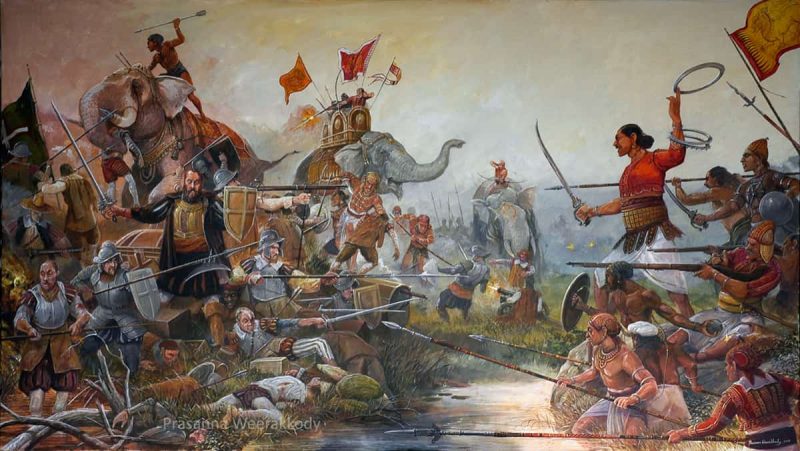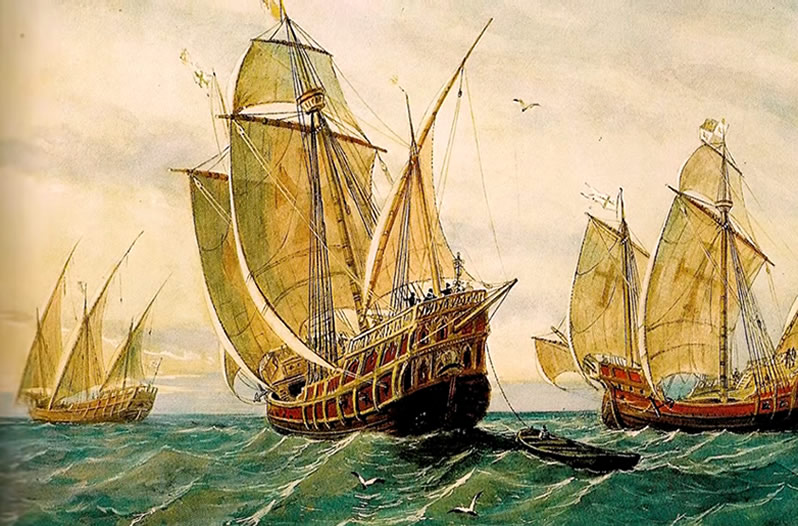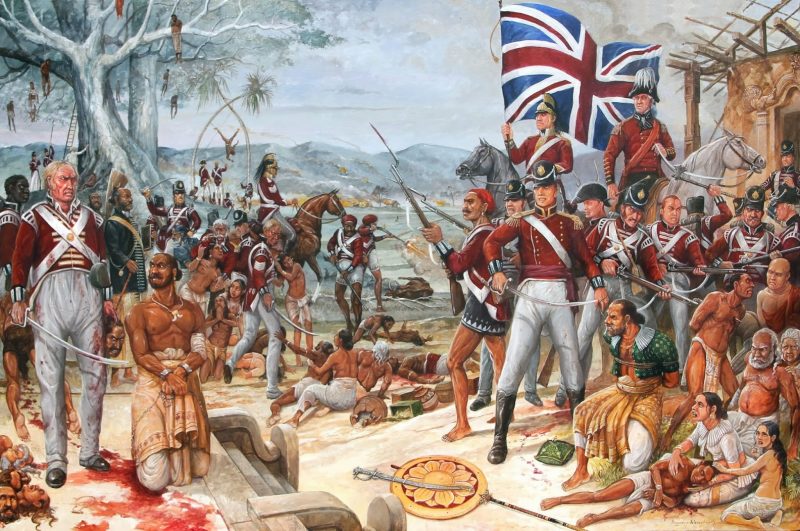The British Attempt On Ceylon
The British Attempt On Ceylon
In the 17th century, when the throne of Kandy had passed to the Nayakkars of South India from King Rajasinghe, there began dealings between the king of Kandy and the British. In 1761, when King Kirthisri was incensed against the Dutch, he sought the assistance of the English on the suggestion of his Nayakkar relatives who were acquainted with the English Company at Madras.
A vakil was sent to intimate to the president of Fort of St.George that the king would be pleased to receive an embassy from the British to concert measures for the expulsion of the Dutch from Ceylon (Sri Lanka). The English were then at peace with the Dutch and could not openly violate their treaty obligations with that nation, but they were eager to have a settlement in Ceylon and a share of the cinnamon trade.
Accordingly, John Pybus, a member of the Madras Council, was dispatched on an embassy to Kandy, in view of the future action, what the king prepared to give in return for assistance against the Dutch.

Pybus arrived in Kandy at Trincomalee in 1762 and was conducted to the capital, but the king and his courtiers were very much disappointed to find that the British ambassador was not able to promise any assistance against the Dutch, and was only intent on ascertaining what concessions that king would make in the event of their assistance, Pybus said they wished to have a settlement at Kottiyar, Batticaloa, or Chilaw, and the monopoly of trade. The king was quite ready to grant all this and even more if the English would only undertake to help him against the Dutch, but as the ambassador would not make any promise, nothing was concluded.
The ambassador, therefore, returned to Madras ill-impressed with the court of Kandy. The king and the courtiers had such an exaggerated notion of their importance and exacted such abject humiliations on the ambassador that negotiations were repeatedly on the point of abrupt termination. But Pybus, having come so far, was unwilling to return without an audience and submitted to the ceremonial with ill grace, being
The second attempt of the English to seize the Dutch settlements in Ceylon was made in 1795 and was crowned with success. During the American war of Independence the heredity stadtholder of Holland, William 4 of Orange, remained pro-English while his subjects sympathized with the revolted colonies. This made William very unpopular in the country, and it needed the intervention of Prussia to keep him in power.
Holland was made a party to the treaty of 1788 concluded at The Hague whereby the English and the Dutch undertook to help each other against the hostile attacks of any European power in India. Thus the English and the Dutch began mutual dealings. The former intervened with their good offices to bring about peace between the Dutch and the Raja of Cochin, in 1789 the English Company supplied rice to Colombo, and the Dutch in their turn sent troops to assist the English in their Indian wars.

The Batavian Republic
But in 1794 the French Republic carried the war into Holland, conquered that country, and set up the Batavian Republic in imitation of the French one, forcing the stadtholder to flee to England. Great Britten thereupon declared war on the Batavia Republic, and that seemed a good opportunity for the English company to occupy the long-coveted settlements in Ceylon.
When the news of this revolution reached Colombo through an unofficial channel; the council met on 12th July 1795 and decided that if the English should attack them, they would be declared that, as they had no official information of the change of government, they adhered to the old constitution of the State-General with a stadtholder; which the council thought would remove all excuse for hostilities. If however, the English should still be hostile, they would defend Colombo, Galle and Trincomalee to the best of their power.
English aims
But meanwhile, the stadtholder was persuaded by his English hosts to send an order to the Cape of Good Hope and Ceylon to admit English troops and ships to prevent the colonies from being seized by the French. This letter was sent to Ceylon through the governor of Madras, Lord Hobart, along with ships and troops. While the fleet took troops to Trincomalee, Major Agnew came to Colombo to deliver the stadtholder.
On the 14th of February, Major Agnew came with a flag of truce to demand the surrender of the town and was conducted with much ceremony to the fort. The council met to discuss the situation, though it was apparent to all that the authorities meant to surrender since they had allowed the invading army to advance unopposed right up to the gates of the city, Changing the mind
At this stage, a new development occurred. The council of Colombo received information that the change in the constitution of Holland had been made by consent of the people and that therefore they were bound to stand by the republic. They, therefore, decided not to submit to the protection of the English on the order of the exiled stadtholder and withdraw their acceptance of the offer of troops and decided to defend their possessions, namely Colombo, Galle and Trincomalee.
Surrender of Trincomalee
The British forces before Trincomalee being immediately informed of this decision proceeded to action and opened their batteries on Fort Fredrick on 23rd August. In three days a breach was made, and the fort was summoned to surrender. The garrison demanded impossible terms, whereupon the bombardment was recommended. Then the troops within the fort mutinied and hoisted the white flag. The terms of capitulation were the following, as shown in the original writing which is still extant.
Reduction of other forts
The fort of Oostenberg which commands the harbour was next besieged, and capitulated on 31st August, on the same term. A detachment under Major Frase proceeded to Batticaloa, which surrendered on the 18th of September. On the 24th, Colonel Stuart set out for the reduction of the remaining Dutch forts.
Point Pedro was occupied on the 27th, and on the following day the fort of Jaffna was summoned, and Commander Raket surrendered with the garrison consisting of 39 Europeans and 98 sepoys. They asked to be sent to Colombo, but the British refused and took them as prisoners of war. The fort was occupied by British troops, and the men of the regiment de Mauron took service under the British.
On 1st October a detachment under Captain Monson occupied the town of Mullaitivu, while the fort and island of Mannar surrender to Captain Burton Gage Barbut on the 5th, the request of the garrison to be sent to Colombo was refused. A detachment which arrived from Pamben under Captain Bowser was dispatched against the fort of Kalpitiya which surrendered on 13th November on being summoned.
Changing the control of the maritime region between the Dutch and English
The control of the maritime region of Sri Lanka was peacefully changed in the hands of the Dutch and English. There were many good reasons for the surrender of the Dutch. When the council of the Dutch East India Company decided in July 1795 to hold out against the English demands, there was some hope of help or instructions from Holland or Batavia or from their French allies; but never a word came from any of them.
There was a talk also that Tippu Sultan would cause a division, but it did not take place. There was in the Company’s stores an immense stock of merchandise un-exported and valued at twenty-five lacs of rupees. The company’s credit was at a very low ebb; the servants of the company had not been paid for months; and what was more, their money had been borrowed by the company; the company’s books were in arrears and the administration was faced with bankruptcy. To add to this, the local troops were deserting in large numbers; most of the Indian sepoys had deserted; Muslims and Malays did likewise; the government coffers were absolutely empty; a Kandyan force was hovering about the frontiers, and there was no hope of holding out for more than three days at most. If the city capitulated, there was some chance of obtaining fair terms, but if it refused, it would have to capitulate at discretion. Thus all things considered the best thing was to capitulate.
Terms of capitulation
The English gave very honourable and advantageous terms. All Dutch officials were permitted to remain as private individuals on the island with a reasonable means of subsistence subject to the approval of the government of Fort St.George. Those who wished to quit the island were allowed to do so with all their effects duty-free. The military was to be prisoners of war and to be conveyed to Madras at the expense of the English. The clergy was to continue in their functions and receive pay as under the Company.
The servants of the Company were given eighteen months to bring their books up to date under pay from the English. All pending cases were to decide within twelve months in the existing courts, all notaries documents and wills were to continue to be in force, and the English government undertook the responsibility for all promissory notes of the Dutch government up to a maximum of £50,000, and would pay three per cent interest as long as they held the lands from Chilaw to Matara. Should they be restored to the Dutch, the responsibility would revert to the company.
The city delivered the English
On these conditions, the Dutch undertook to deliver faithfully Colombo and the entire places dependent thereon such as Kalutara, Galle and Matara, with all the merchandise, stores and public property on land or laden in the ships. These terms were carried out at ten o’clock on the 16th and all the settlements of the Dutch East India Company passed into the possession of the English East India Company, without a struggle, without loss of life, without much expense and without let or hindrance from the king of Kandy.
French failed to annex Ceylon to their colony
In France, as in Holland and England, companies were formed from trade in the East. In 1664 the earlier companies were merged into an East India Company with royal support. Francois Caron, the Frenchman who had served the Dutch Company and had recaptured Negombo in 1644, offered his service to his own countrymen and persuade them to seek a port in Ceylon. Caron was made director-general in India and set out to make the venture. He founded a French factory at Surat and communicated with Rajasinghe through a Portuguese merchant.
Admiral de la Haye
A French royal squadron under Admiral de la Haye soon followed. Taking Caron on board it set out for Ceylon and arrived at Trincomalee in March 1672. The Dutch at once abandoned the fort of Kottiyar and betook themselves to Trincomalee.
De la Haye and Caron chose the two islands in the Bay of Trincomalee. De La Haye and Caron chose the two islands in the bay of Trincomalee for their fort and factory and sent envoys to Rajasingha to announce their arrival. A spy sent by the Dutch came to assure the French that the king was at peace with the Dutch and needed no help from the French, but the admiral took no notice of him. Thereupon the Dutch sent a peremptory order to the admiral to quit the bay, which the Frenchman treated with contempt.
Treaty with the French
Meanwhile, the envoy sent to Kandy returned with two chiefs and a numerous suite, and on 6th May a treaty was drawn up between the French and Rajasinghe, giving the French the ports of Trincomalee, Kottiyar, and Batticaloa. But the king’s men did not bring provisions for the French fleet, and the admiral sent a man named de la Nerolle to Kandy to press for provisions.
The messenger, unaccustomed to diplomacy, acted so arrogantly at court that the king beat him and clapped him in chains. Meanwhile, the fleet was badly in need of victual and set sail for India, leaving a garrison in the fort. As soon as the fleet sailed away, the Dutch besieged the fort, and though a general of Rajasinghe routed the first advance of the Dutch troops, the garrison had to surrender on the explicit understanding that the capitulation was not to affect their rights to the fort. The Dutch took the French captives for exhibition from port to port as the miserable remnants of the French fleet.
Our articles under the title “Places to visit in Sri Lanka“
- 10 Best Places To Visit In Sri Lanka For Honeymoon In 2021
- 15 Best places to visit in Sri Lanka in 3 days
- 7 Places To Visit In Sri Lanka South Coast Itinerary
- 22 places to visit in Sri Lanka in 5 days
- 12 best places to visit in Sri Lanka in 2 days
- 15 Places to Visit In Sri Lanka In Two Weeks
- 18 Best Places to Visit in Sri Lanka in 14 Days
- 10 Places To Visit In Sri Lanka Trip Itinerary
- Places To Visit In Sri Lanka In 6 Days
- Best places to visit in Sri Lanka off the beaten track
- Places to visit in sri Lanka within one day
- Places to visit in Sri Lanka in 4 days
- Places To Visit In Sri Lanka In 7 Days
- 10 Best Places to Visit in Sri Lanka Itinerary 8 Days
- What are the 20 Best Places to Visit in Sri Lanka in December?
- What are the 6 best places to visit on a 5-day trip to Sri Lanka?
- 7 PLACES TO VISIT ON SRI LANKA HERITAGE TOURS
- 10 Places To Visit In 9 Days In Sri Lanka Car Tours
- 8 Days In Sri Lanka And 15 Best Places To Visit
- SIGIRIYA ROCK FORTRESS SRI LANKA AND PLACES TO VISIT IN SIGIRIYA
- What are the top 11 places to visit in Mirissa Sri Lanka?
- 17 Best Places To Visit On Sri Lanka Hill Country Tours
- What are the 10 best places to visit on the Kandy tea plantation tour?







One thought on “The British Attempt On Ceylon”
Comments are closed.